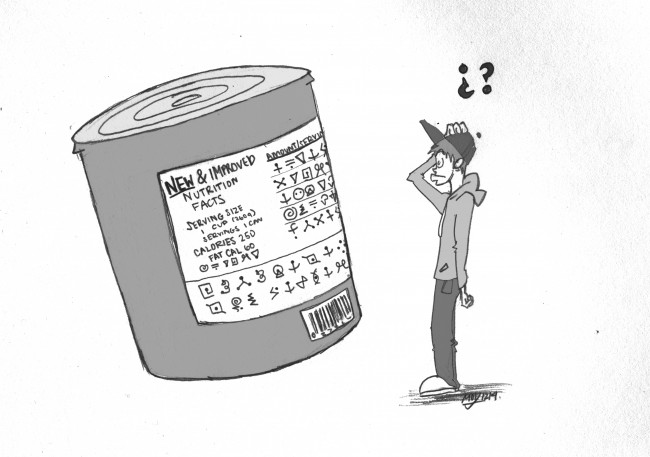
Nutrition. Calories. Sugar. Serving sizes. These are just a few of the words the public hears or sees, if not on a daily basis, at least on occasion, even if they aren’t consciously aware of it.
In an attempt to help consumers make healthier decisions in regards to what they eat and drink, the Food and Drug Administration is proposing a new rule— to revamp the nutrition facts and supplement facts labels on the products people consume.
This is one of the first major changes proposed since 1993 when the FDA created new rules for labels, including a modification on how nutrient information is presented on food labels and which nutrients are required or permitted to be declared.
The new proposal “will amend the definition of a single-serving container, require dual column labeling for certain containers, update the reference amounts customarily consumed and serving sizes for several food product categories and amend the serving size for breath mints,” according to the FDA.
Parts of this revamp seem to be heading in the right direction. Increasing the font size of the calories is a good idea in theory. If put into effect, it will more than likely help people when deciding what to buy for themselves and their families. Big and bold usually means important in terms of what’s in print.
The one potential concern here, though, is how big will this one aspect of the label be? Will it cause other nutrition facts to be put on the backburner by making their print smaller? Or will the entire label span the length of the can, box or bottle and make the product name less noticeable? The latter seems like a better alternative here.
Another amendment to the labels will be including added sugars and not just sugars as a whole. Basically, this means that consumers will know how much sugar was added during processing.
Unfortunately, it appears as though this will only consist of the number of grams of added sugars, rather than defining what added sugars are. Terms such as high fructose corn syrup, corn syrup, dextrose, fruit juice concentrate and molasses all mean sugar.
Maybe the FDA should make a requirement that other words or phrases for sugar have the word ‘sugar’ in parentheses next to it. Or list these sugary ingredients separately, so people know exactly how many ingredients are in this one category.
The FDA is also looking at changing serving sizes for certain products. Currently, 8 fluid ounces is the normal serving size for drinks while a pint of ice cream has 4 servings inside, usually about a half cup for one serving. Under the new proposal, 20 fluid ounces would become one serving, and 2 servings of ice cream (1 cup) would become one serving, cutting the number of servings down from 4 to 2 in a single container.
Since grade school, most of us have been inundated with classes teaching us about being healthy. It’s called health class. In fact, the California Department of Education has a 71-page document on its website called Health Education Content Standards for California Public Schools: Kindergarten through Grade Twelve that was published in 2008.
The text breaks down health education into six categories—Nutrition and Physical Activity; Growth, Development, and Sexual Health; Injury Prevention and Safety; Alcohol, Tobacco, and Other Drugs; Mental, Emotional, and Social Health; and Personal and Community Health.
As early as kindergarten, concepts such as identifying healthy snacks, naming a variety of healthy foods and explaining why they are necessary for good health, and planning a nutritious breakfast are outlined as recommendations for health material.
The concepts become more complex and age-appropriate as students progress through grade levels. Theodore R. Mitchell, then president of the State Board of Education and Jack O’Connell, then state superintendent of Public Instruction, wrote a message stating that “Good health and academic success go hand in hand. Healthy children make better students…Students need health education.”
So if children are being taught at such a young age about healthy eating, then why the change in updating serving sizes? Shouldn’t we know what is healthy or not to put into our bodies at this point in our lives and how much should be consumed?
Foods in their natural state tend to be the best to eat and drink. Items such as water, fresh fruits and vegetables. Typically, the more things listed under the ingredients section on a label, the less healthy that particular product is going to be. Half the time, we can’t even pronounce the ingredients.
A comment period will open to the public on March 13 and will close on June 2 at 8:59 p.m. Pacific Standard Time. To submit a comment online, visit http://www.regulations.gov and enter docket number FDA-2012-N-1210 or the regulatory information number 0910-AF22 in the search bar to be directed to the proposed rule.
What we consume is important to us. Understanding what is in our products should be important to us. Participate in these online forums and let your voice be heard. Americans deserve to understand what we are consuming.





